Smoked flank steak is one of the most tender, juicy smoked steak recipes around. Flank is a lean cut of steak and is perfect for this easy smoker recipe, which can go from grill to plate in about an hour. It's a great option for healthy weeknight dinners and is one of my favorite Traeger recipes of all time!
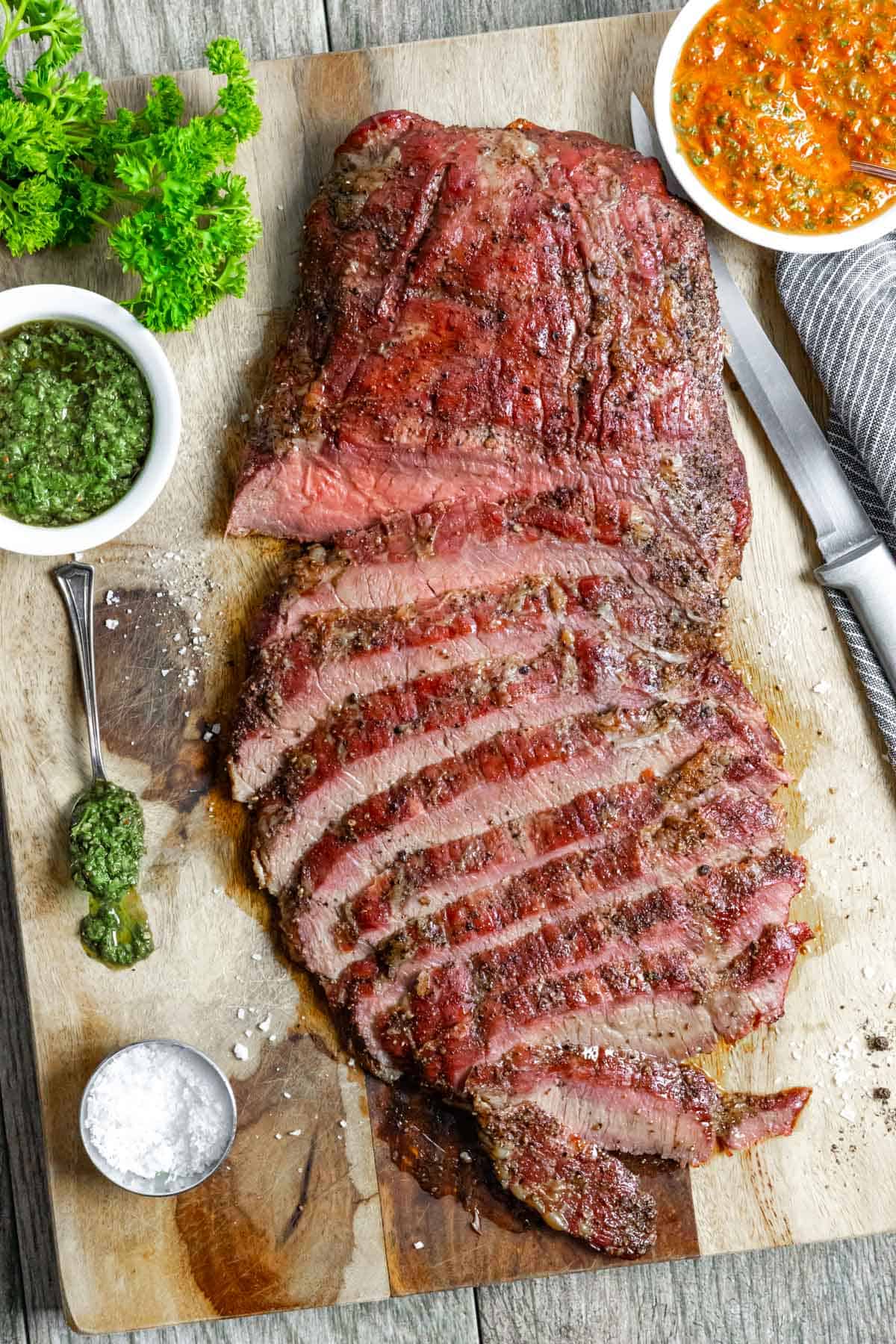
Jump to:
- Why you’ll love this recipe
- What is flank steak?
- London broil vs flank steak – are they the same?
- What is the best wood to use to smoke flank steak?
- Ingredients
- Sear vs reverse sear
- Should I use a searing plate?
- Instructions
- Expert tips
- How to determine doneness
- How long to let steak rest
- Resting guidelines
- How to cut flank steak
- Meat thermometer recommendations
- How to serve
- How to store
- How long does steak last in the fridge?
- Can you freeze cooked steak?
- FAQ
- Great sauce pairings
- 📖 Recipe
- 💬 Comments
The flank is an often overlooked and underrated cut of beef. However, it has some of the best flavor and is perfect for smoking on a pellet grill. It makes one of the most drool worthy, juicy steaks I’ve ever had the pleasure of eating. Serve it with an appetizer of cold Cucumber Gazpacho for an amazing meal.
Contrary to popular belief, you don't need to tenderize this cut. Pounding or marinating is not neccesary. The trick is to not overcook it, keeping it tender and juicy.
Of all meats, I enjoy smoked beef the best, with smoked pork belly being a possible exception. My Traeger Beef Ribs are flavorful and succulent and come off the grill with the best bark. There’s nothing like ribs cooked low and slow, served with some delicious Cilantro Lime Coleslaw and Cheddar Biscuits.
If you're a dessert lover like me, serve up some berry bliss with a Lemon Raspberry Bundt Cake or this super easy Strawberry Clafoutis with sugar-free whipped cream. Berries are just so, so good with barbeque. If you don't feel like firing up the oven, Pina Colada Panna Cotta with Pineapple and Lime is a great no-bake dessert and compliments those smoky rich BBQ flavors.
Why you’ll love this recipe
- Number one reason – it’s absolutely amazingly delicious!!
- It’s a very easy smoker recipe and cooks up in no time on your pellet grill
- Flank steak is a very affordable cut of beef and makes great leftovers
- You won’t dirty a bunch of dishes making flank steak on Traeger grills or other smokers
- If you follow a special diet, this is a paleo, keto-friendly and low-FODMAP dinner recipe
What is flank steak?
This cut comes from the abdominal muscle of the cow. When compared with other cuts, it tends to be tougher due to its high concentration of muscle fibers.
It’s a thin, wide cut, typically about 1.5 inches thick. It's very lean, with minimal marbling and a noticable grain of meat fibers that run in lines down the long side of the meat. Due to its leanness, it’s a great source of protein, with little saturated fat, making it a heart-healthy cut of beef.
Even though it’s naturally not as tender as other cuts, it's very rich and tends to absorb flavor from rubs and marinades easily. However, for this recipe, salt and pepper are all that's needed. Sometimes simple is just better.
The flank cut is known for its use in jerky and is often confused with London broil and skirt steak.
London broil vs flank steak – are they the same?
The term ‘London broil’ actually refers to a preparation method rather than a specific cut of meat. It is beef that has been marinated in a liquid mixture that often includes vinegar, Worcestershire sauce, soy sauce, lemon, garlic, mustard, sugar, pepper and olive oil. After marinating, it’s traditionally broiled in the oven.
London broil is a dish made from tougher cuts of meat, such as round steak, flank or sirloin. However, many butchers use the term to refer to any large, lean cuts of tough meat.
What is the best wood to use to smoke flank steak?
The variety of wood to use is really personal preference. I use the Traeger maple-hickory-cherry blend. It adds great flavor, while not being overpowering. If you want stronger smoke, consider using woods such as hickory or oak, which impart bolder flavor to the meat.
Cherry, maple, pecan, apple or alder are also good choices.

Ingredients
A phenomenal smoked steak does not require a steak marinade. Sometimes less is more and this is definitely one of those times. This is a very easy recipe and only requires 3 ingredients:
- Flank steak – these tend to vary in size, but most typically weigh around 2 pounds and are about 1 to 1-½ inches thick
- Salt – I really like using flake salt. I love the way it dissolves slightly on the surface of the beef, which gives just a hint of saltiness with every bite. Totally mouthwatering.
- Black pepper – I recommend using a medium or coarse grind. It’s not only visually appealing, but adds a more potent flavor than fine ground pepper. However, if you only have fine ground pepper, that works great, too. I recommend freshly cracked, as the volatile aromatics will get absorbed better in the meat.
Some people choose to add a coating of olive oil to the surface of the meat to help the salt and pepper adhere. You can add a coating if you wish, but I find that it’s not needed.
If you want a savory spice variation, try using this All-Purpose Seasoning Blend in place of salt and pepper. It's my go-to seasoning for just about everything!
Sear vs reverse sear
Traditional searing refers to performing the sear step first, then cooking the meat until the interior comes up to temperature. You’ll get a large outer band of well-done meat, surrounding more tender, rarer meat, cooked to the proper temperature. This is optimal for cooking most thick cuts, but not for flank because it's so thin and prone to overcooking.
The reverse searing method is where the meat is first cooked to a desired temperature, then seared to bring it to the final desired internal temperature. This allows the smoke to absorb into the meat, and you get a tender, flavorful, more evenly cooked steak, without overcooking.
Of the two methods, I would choose to reverse sear on the Traeger because it is the best method to keep this particular cut from over cooking. If it is over cooked, it can be tough, regardless of how you cut the meat (see below for how to cut flank steak).
Should I use a searing plate?
You can use one you want to, but it isn’t necessary. I use a high heat cooking method after the smoking stage that will create a nice sear from the grill on each side of the meat.
If you wish to use a sear plate, place it in your smoker during the high heat step of this recipe.
Instructions
Smoking is my favorite way to prepare this cut, even over making broiled or cast iron flank steak in the oven. It takes on just the right amount of smoke and is so incredibly good with just salt and pepper.
Smoking for only 45 min on a low setting imparts smoke flavors, but won’t dry out the meat and make it tough.
Pre-heat the smoker to smoke at 180°F.
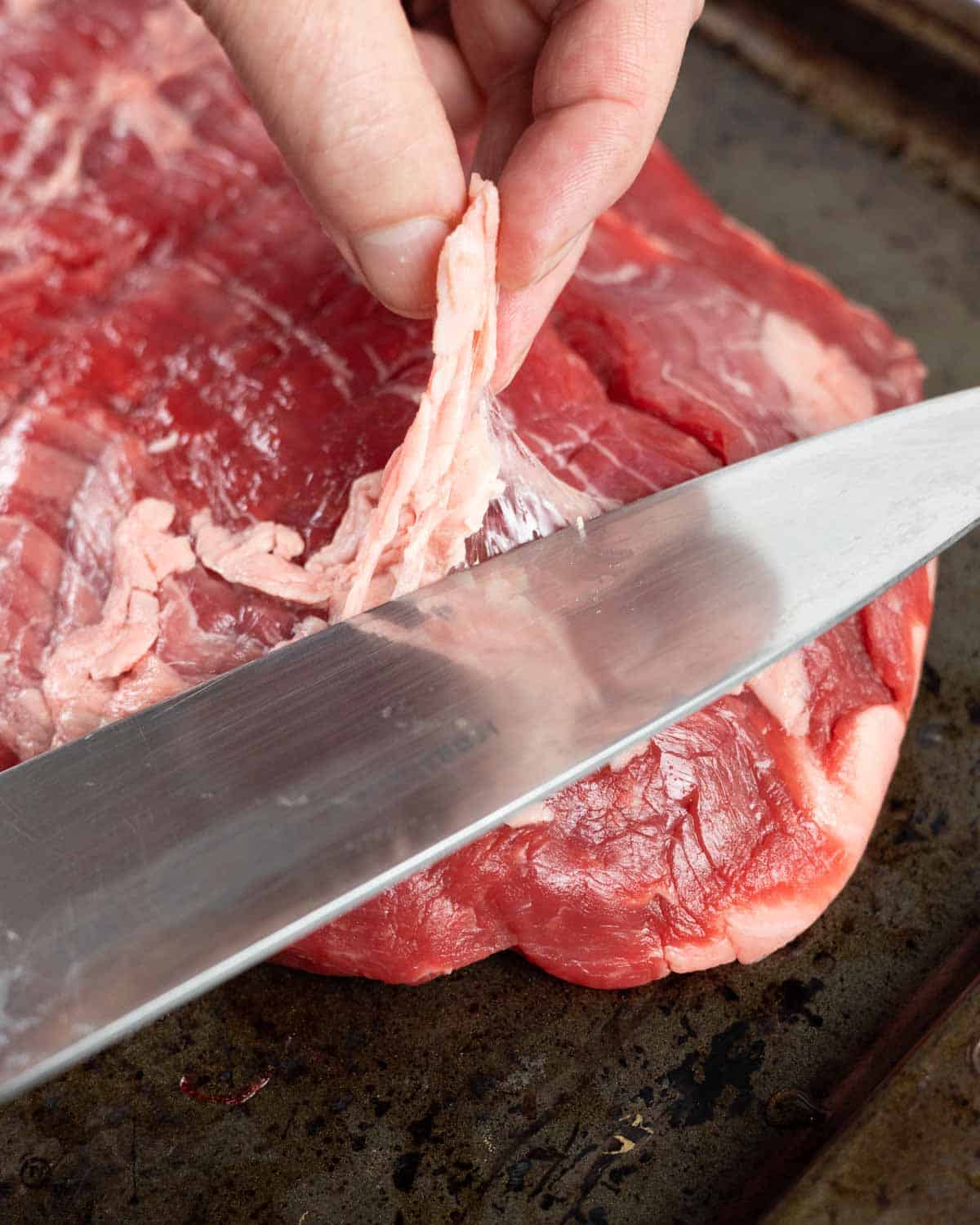
- Trim any excess fat or silver skin (optional)
- If there are very thin spots at the end of the cut, trim those off, as they tend to get over-cooked
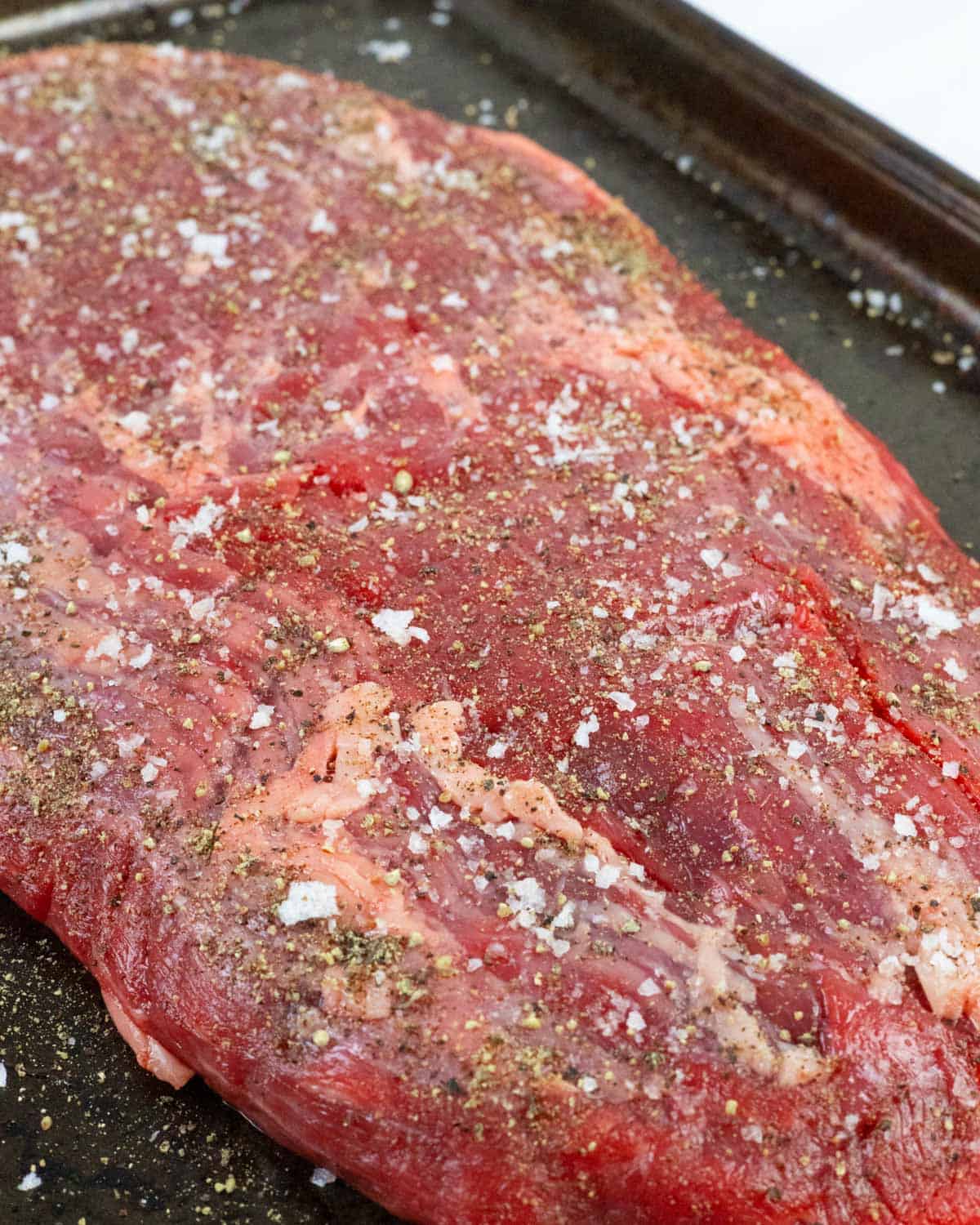
Season both sides of the meat.
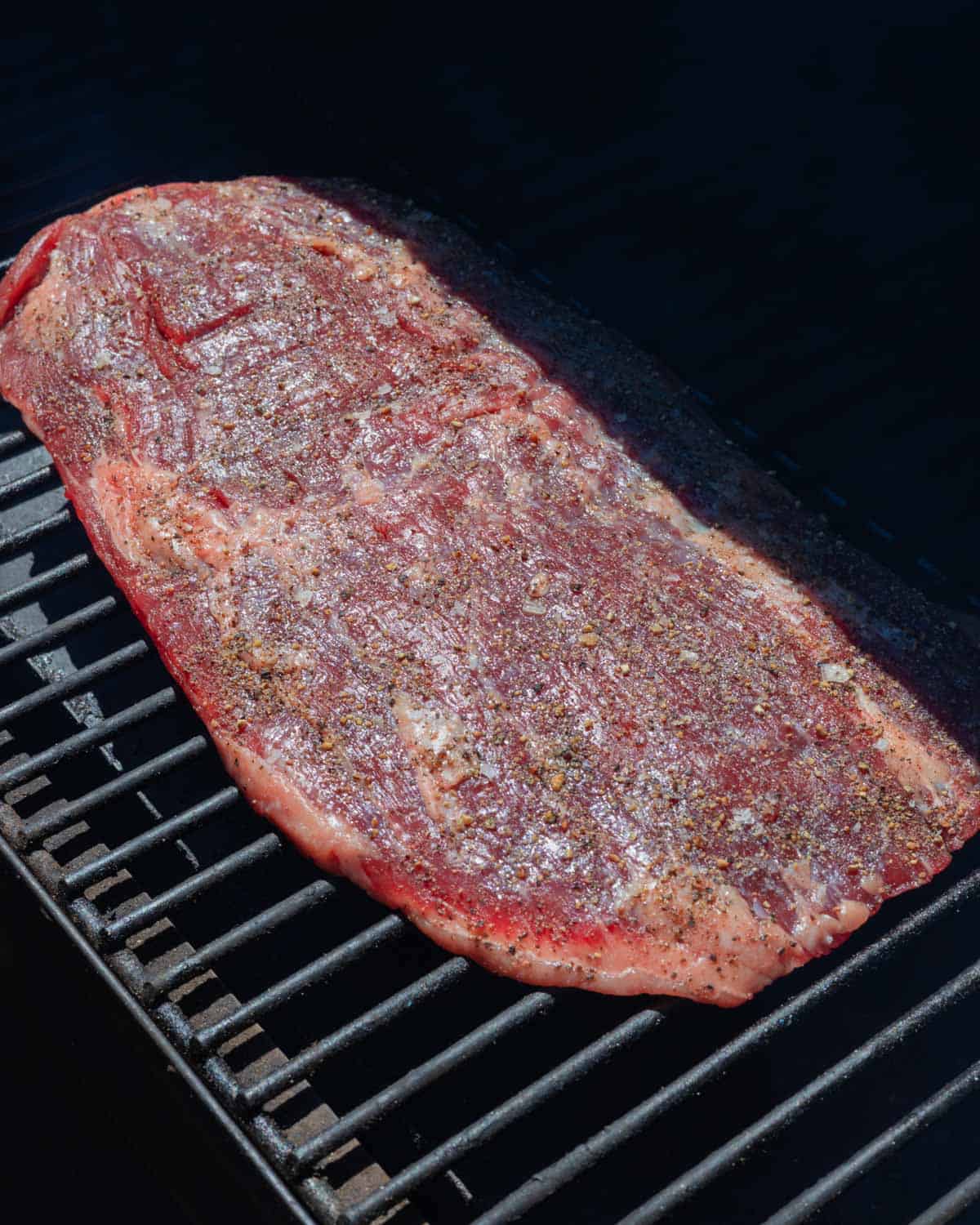
Place on the grill, close the lid and smoke for 45 minutes.
- Remove from the grill and place onto a platter or baking sheet and cover loosely with foil (note: the meat will still appear raw at this step)
- Turn up the grill to 450°F
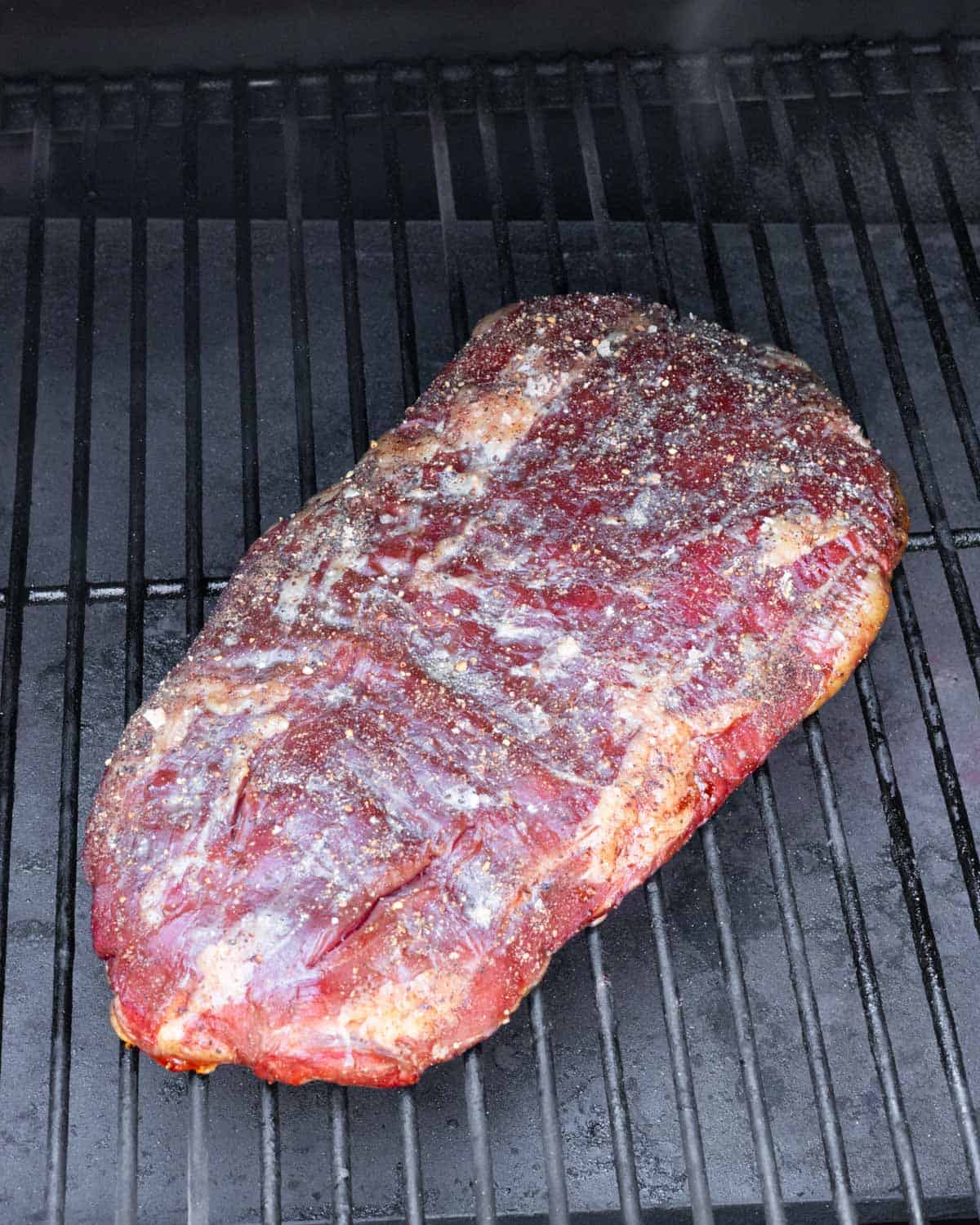
Once the smoker has reached 450°F, return the steak to the grill, close the lid and sear for 3 minutes for medium and 4 minutes for well-done (see notes about internal temperature).
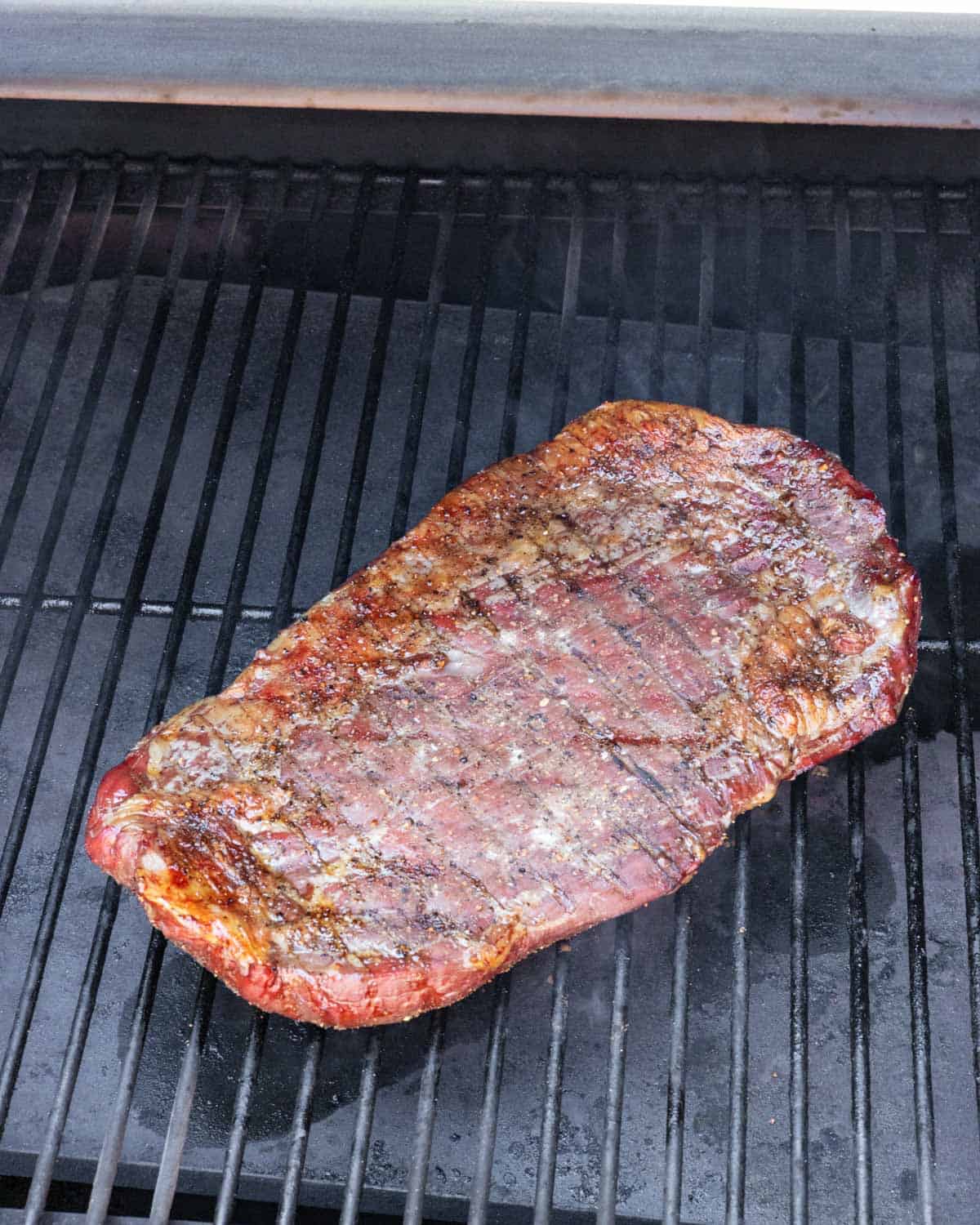
Flip, then sear for an additional 3-4 minutes with the lid closed.
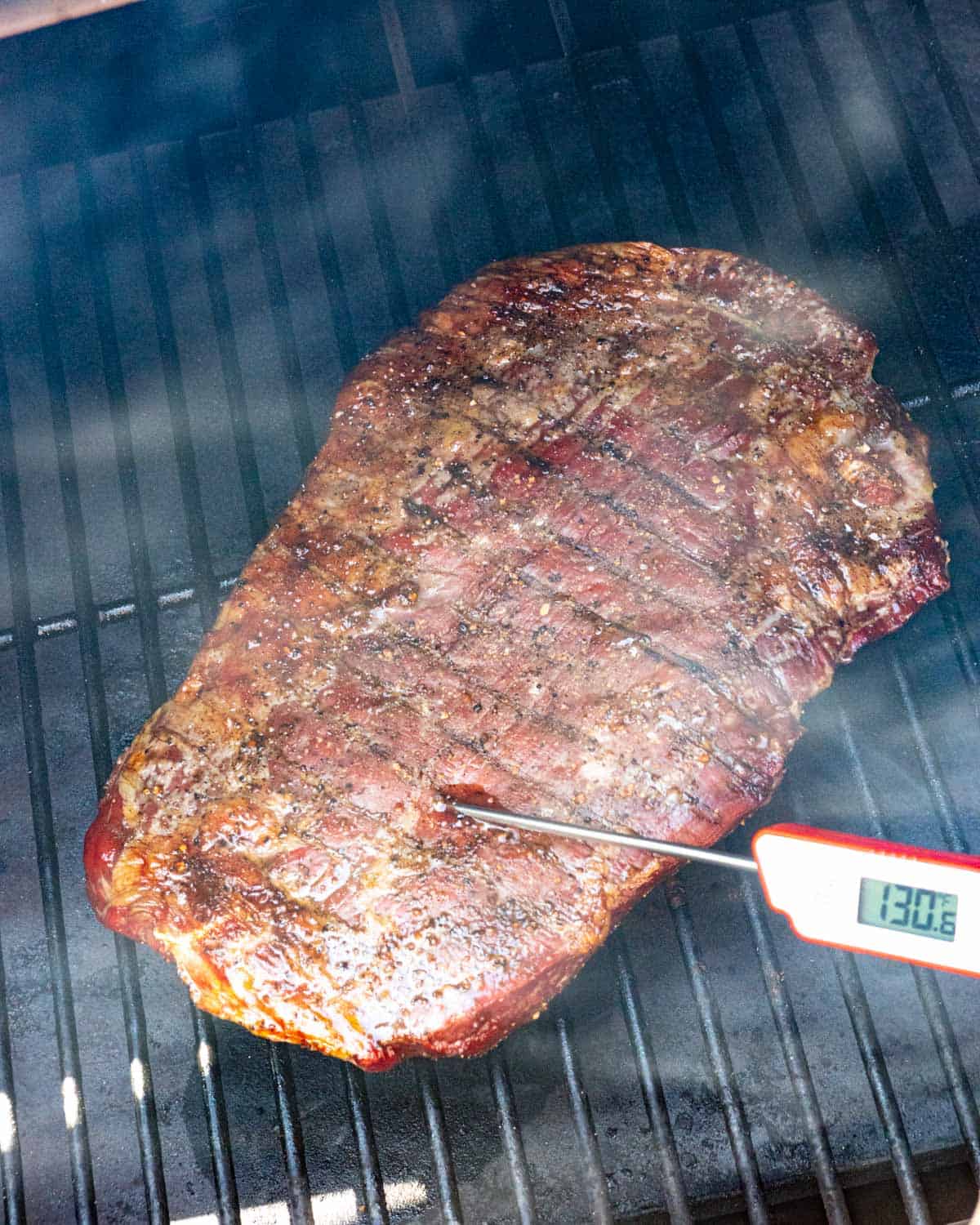
Insert an instant-read meat thermometer into the thickest part of the meat to test for doneness. Since this is a thin cut, insert the thermometer at an angle. See below for how to determine doneness of beef.
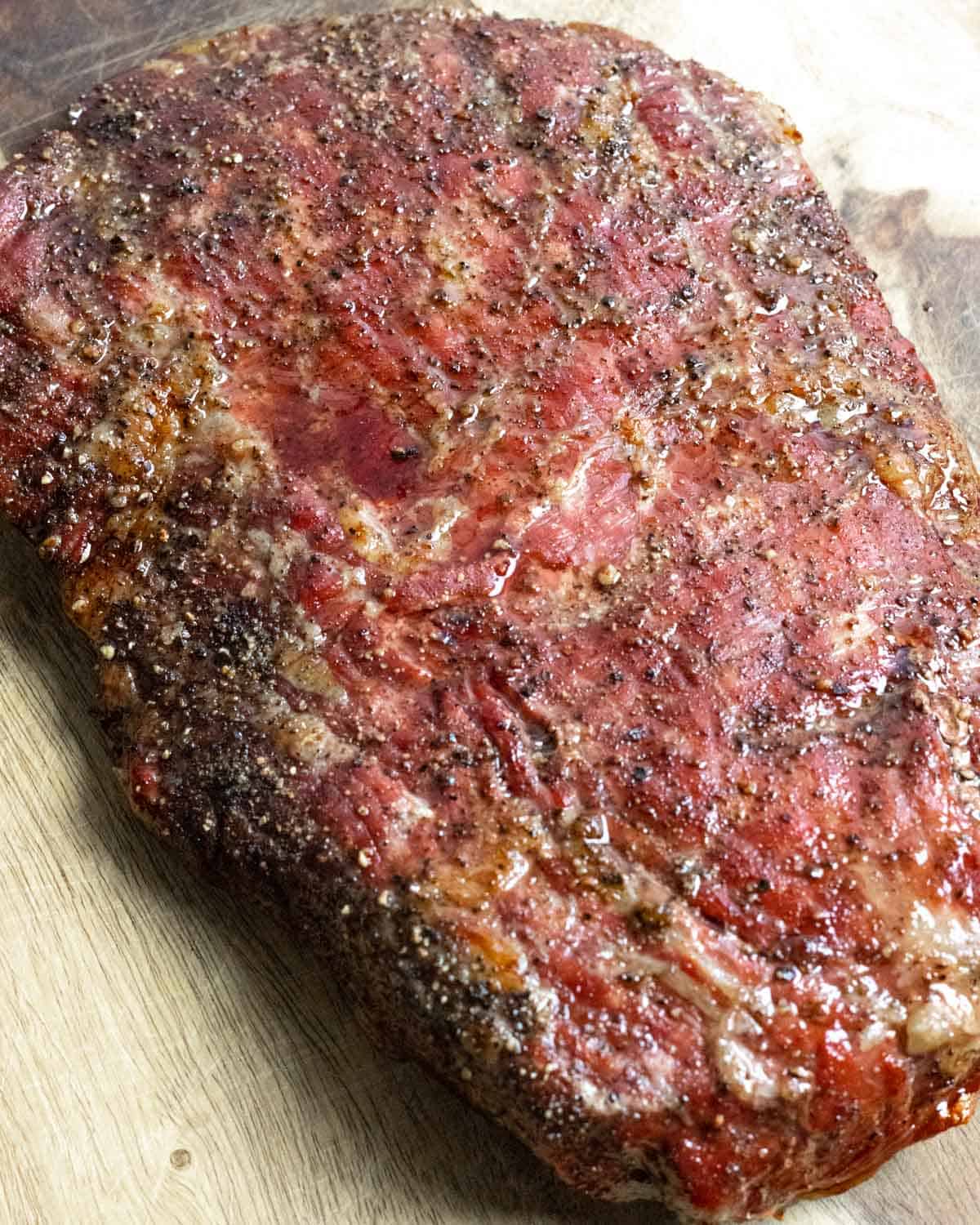
Remove from the grill, Lightly cover with foil and let rest for 5-10 minutes before slicing. This step allows the muscle fibers to contract and reabsorb moisture. It stays juicier and is easier to slice.
Expert tips
- Try dry marinating overnight. Season the meat, then let it sit overnight in the refrigerator on a sheetpan covered with foil or plastic wrap. The seasoning penetrates the meat for an even more outstanding flavor.
- Take the meat out of the fridge for about 30 minutes before smoking. It allows the meat to get closer to room temperature, which results in a more even cook.
- Covering the meat with foil keeps it warm after it reaches its optimal internal temperature while resting
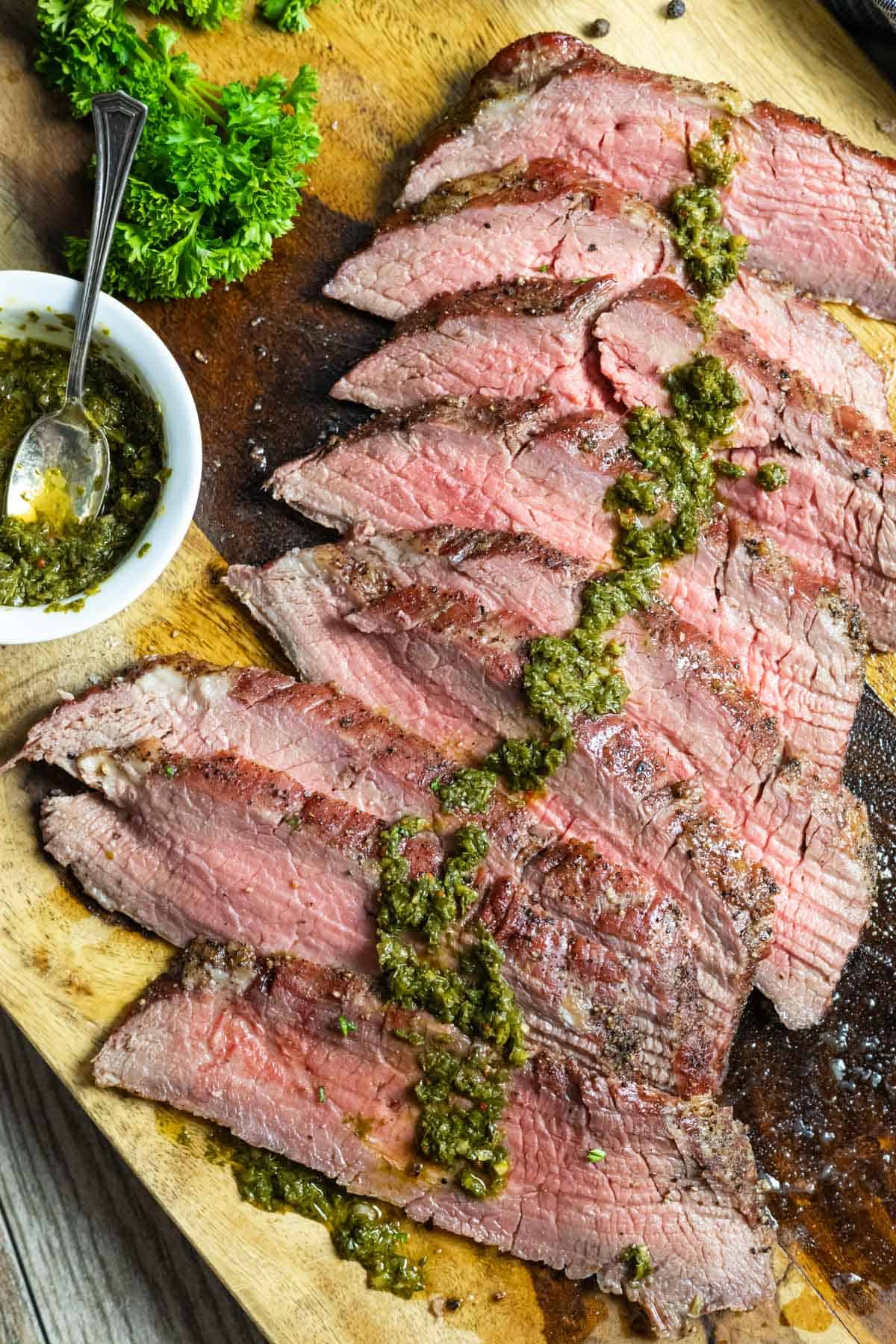
How to determine doneness
After searing, the steak should be removed from the grill when the thermometer reads 5°F-10°F lower than your desired doneness, as the temperature will continue to rise during the resting period. However, this will vary depending on the cut of meat.
For this cut, I removed it at 135°F for a perfect medium doneness after resting.
Here are general guidelines for doneness based on internal temperature:
- Rare - the outside is seared with a cool red center. Temperature is about 125°F.
- Medium rare - the center is warmer red and temperature is about 135°F
- Medium - the center is a warm pink and temperature is about 145°F
- Medium well - has a slightly pink center and temperature is about 155°F
- Well done - has no pink and temperature is about 165°F
USDA recommends beef steaks and roasts be cooked to at least 145°F (medium) to ensure food safety.
How long to let steak rest
Resting is an essential part of the cooking process for most meats. Allowing meat and poultry (and some fish) to rest lets the juices reabsorb and redistribute into the muscle fibers as they contract during the cooling process. This ensures the meat is moist and flavorful.
This is very important due to a process called carryover cooking. Carryover cooking means that your food is still cooking after you remove it from the heat source. While your meat is resting, the outer layer of the meat is cooling, but the internal temperature is continuing to rise, which is referred to as latent heat.
When the meat is removed from the heat source, the outer layer will be considerably hotter than the interior. Resting allows the outer layer to cool, while the internal temp rises a bit, usually between 5-10 degrees, depending on the cut. When the outer temperature and inner temperature are the same, your meat is considered to be fully rested and ready to slice.
As a general rule, the thinner the cut, the less resting time is required.
Resting guidelines
- Rest meat for 5 minutes per inch of thickness
- For roasts and larger cuts, allow 10 minutes of resting time per pound
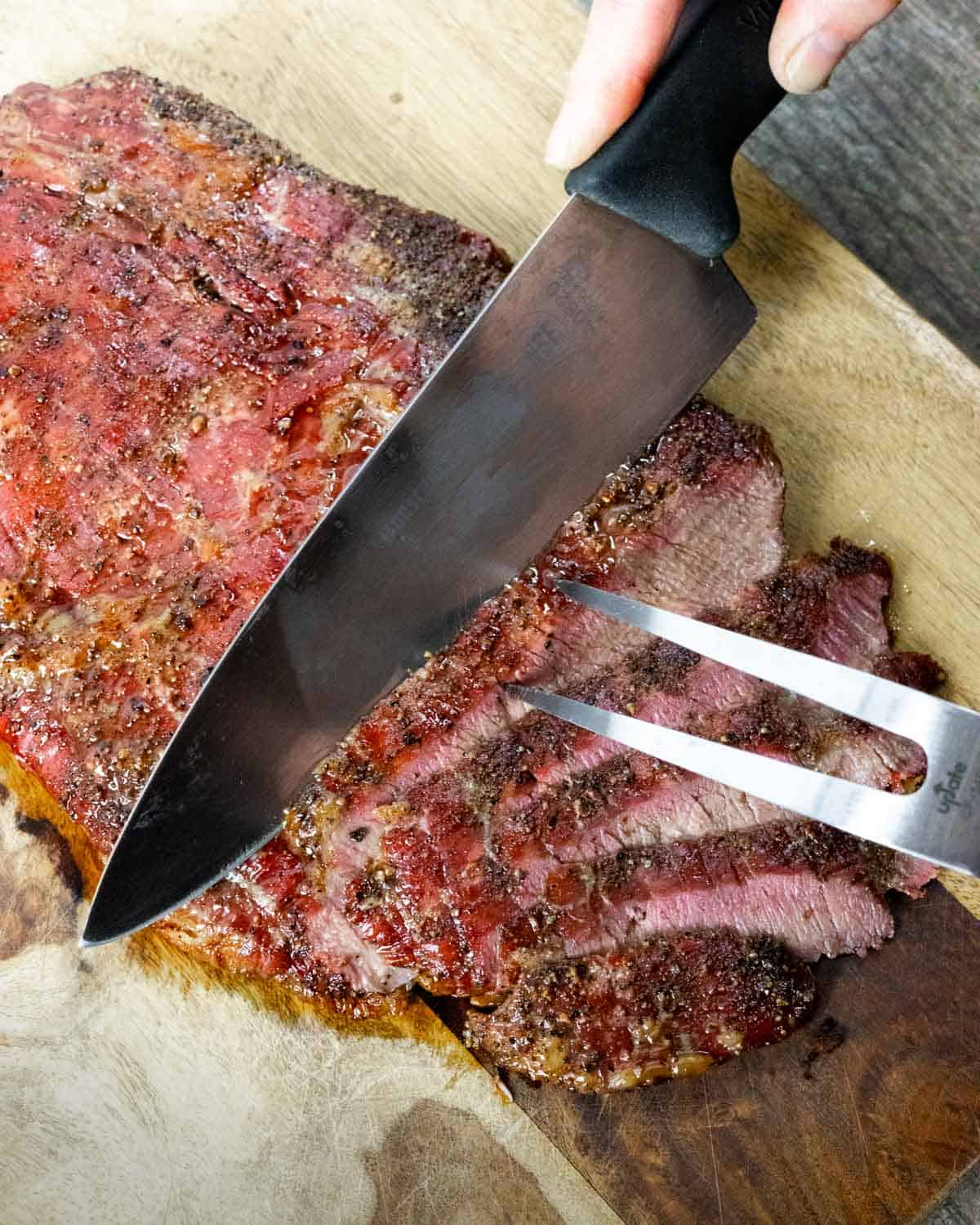
How to cut flank steak
Once it has rested, it’s time to slice. The way you cut this particular cut of beef makes a BIG difference.
Slice flank steak against the grain to keep it nice and tender. Slicing with the grain will make it tough and chewy.
How do you determine steak grain and how do you cut against the grain? Easily. It’s all about looking for the direction of the muscle fibers, which is very simple. On a flank, they run from the thickest to the thinnest part of the cut. You’ll see long lines running from one end to the other – those are the muscle fibers.
To cut against the grain, simply slice the meat across those fibers.
For the best cuts, use a sharp knife and cut at an angle of about 45 degrees. This will create wider slices. However, if you want to keep your slices thinner, then slice straight down. It's really about personal preference and the dish being served.
Meat thermometer recommendations
An instant read thermometer is best for smoking thin cuts of meat. Dial thermometers take time to read the temperature which can lead to overcooking. Instant-read thermometers calculate the temperature in seconds (or less) and allow you to remove your meat from the grill at your desired temperature, with no surprises.
There are many different types of instant-read thermometers, with varying price points. I use a ThermoPro thermometer, which has worked really well. I also love the Meater thermometer which is a top-of-the-line wireless smart thermometer. You can insert the probe into the meat, close the grill lid and check temperature through an app. It doesn't get better than that. However, the Bluetooth, wireless thermometers tend to be a bit thick in diameter. Using a thinner thermometer such as the ThermoPro might be a better option for thinner cuts of meat like flank or skirt steaks, where inserting a larger diameter probe may be challenging.
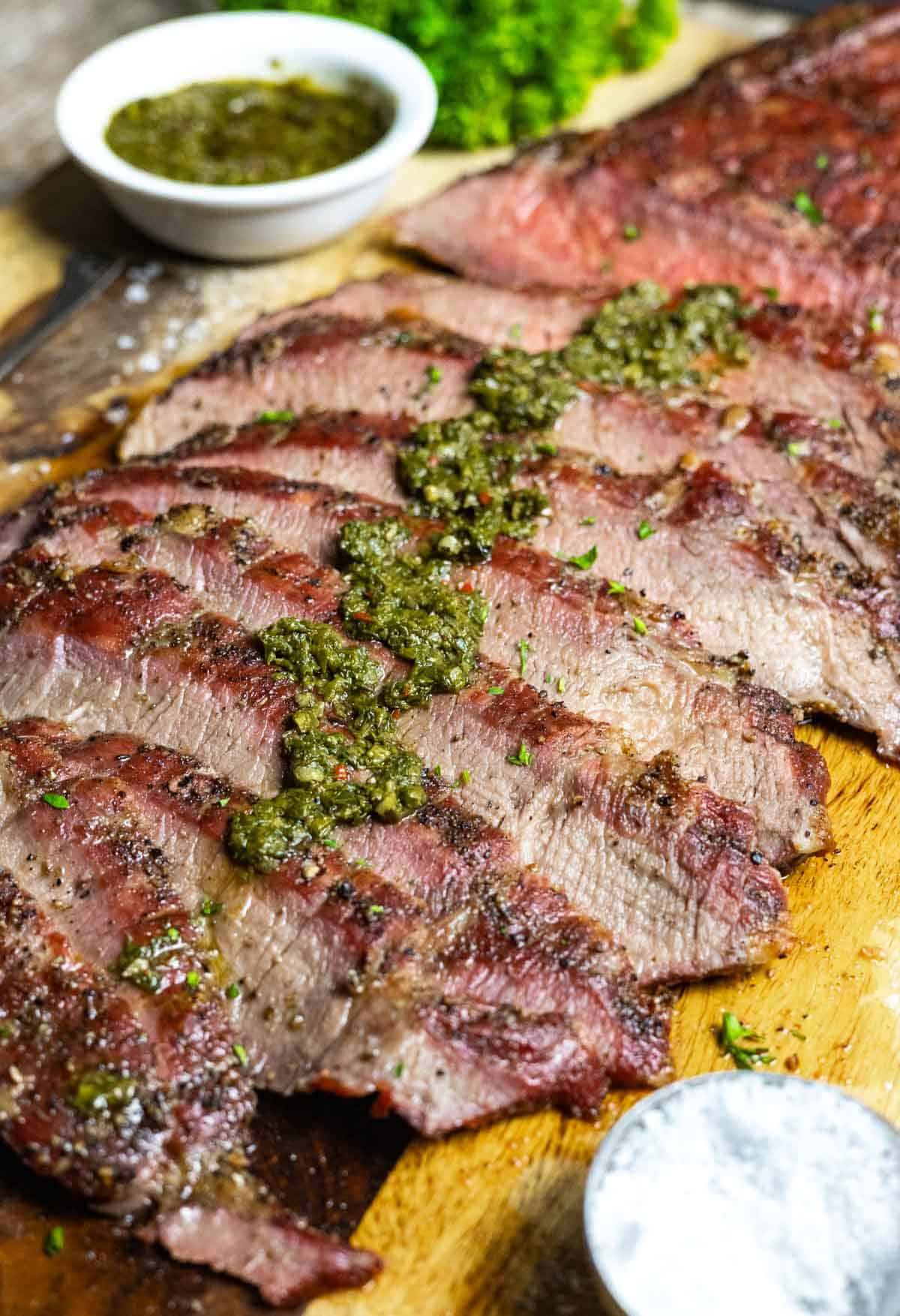
How to serve
Use this versatile cut of meat for a variety of dishes.
- Top with chimichurri sauce – this is a true match made in Heaven. Flank steak with a slightly acidic chimichurri sauce is just magical. Try this Red Chimichurri or Mexican Chimchurri sauce to drizzle over the slices.
- Top with a horseradish sauce – a zesty, creamy and slightly spicy homemade Horseradish Mustard Sauce complements the smokey flavor of the meat
- Simply serve sliced – with your favorite side dishes, such as Maple Rosemary Brussels Sprouts, Cauliflower Rice or Cilantro Lime Coleslaw as chimichurri steak sides
- Use a steak dipping sauce – my low carb backyard barbecue sauce, low-FODMAP BBQ sauce, or Homemade No-Cook barbecue sauce (made with ketchup) are great options to sauce up your flank
- Make chimichurri steak tacos – pile up your favorite tortillas with grilled vegetables, shredded cheese and slices of smoked steak
- Steak and eggs – I absolutely love serving a couple of slices alongside eggs for breakfast. So, so good.
How to store
Keep this and any other cooked meats in the coldest part of the refrigerator with plenty of air to circulate around the container to keep it cold. Store in a sealed bag, an airtight container or on a covered plate.
How long does steak last in the fridge?
Cooked steak can last up to 4 days in the refrigerator, if properly stored.
Can you freeze cooked steak?
Yes! Freeze leftovers in airtight containers, freezer bags or wrap in foil and freeze for up to 6 months.
FAQ
No – the flavor can come from a dry rub as well as a marinade for steak. This flank steak recipe uses only salt and pepper, letting the flavor of the meat shine. Its tenderness relies on cooking temperature, not overcooking and correct slicing.
Yes! Eliminate the smoking step and skip right to the grilling. Grill at a high temperature of 425-450F for 4-6 minutes per side, depending on your desired level of doneness. Remove when the meat is 5-10 degrees below your desired temperature.
Is skirt steak the same as flank steak? No – they are actually two different cuts of meat, coming from different parts of the cow. Flank comes from the abdomen and tends to be more tender and lean than the inside skirt cut. Skirt comes from the plate primal and has an inner cut (from the abdomen) and an outer cut (from the diaphragm). Flank tends to be wider and leaner, where skirt is thinner and fattier. On flank, the grain runs the length of the meat, where on skirt, the grain runs crosswise.
An alternative to flank steak is skirt steak. The two are very similar and take well to smoking and grilling. However, hanger steak also makes a great substitute for flank steak.
The most popular alternative name for flank is London broil. It's commonly referred to as London broil at the grocery store, butcher or on a restaurant menu. While this is a reference to a cooking method rather than a cut of meat, chances are, the cut that is used is flank.
Did you make this recipe? Let me know how you liked it by giving a star rating and leaving a comment!
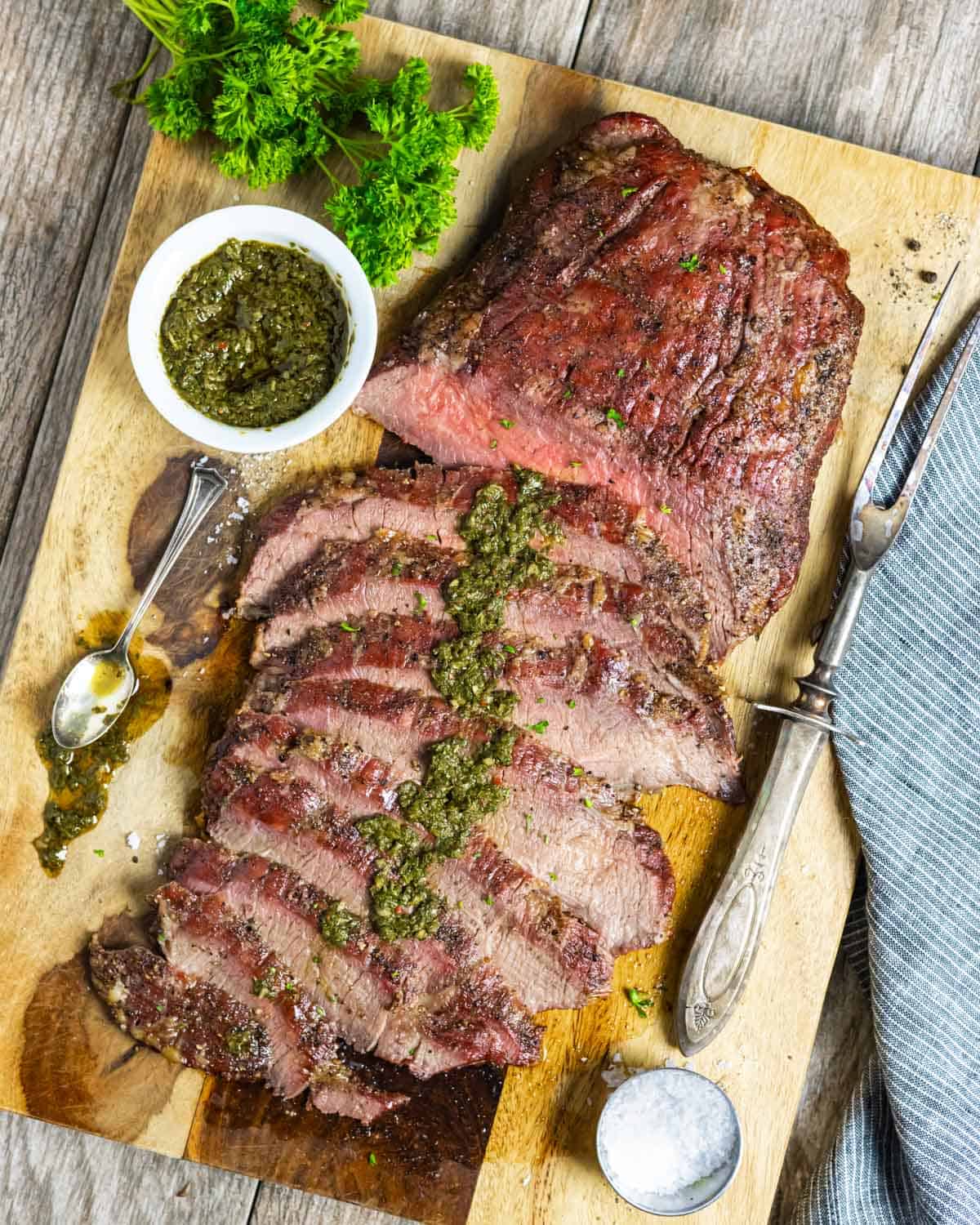
📖 Recipe

Smoked Flank Steak
Ingredients
- 1 flank steak (average 2-3 pounds)
- 2 teaspoons flake salt
- 2 teaspoons black pepper (coarse grind is best)
Instructions
- Pre-heat the smoker to 180℉
- Trim any chunks of fat or silver skin (optional). If there are very thin spots at the end of the cut, trim those, as they tend to overcook.
- Season each side with 1 teaspoon of salt and 1 teaspoon of pepper
- Place the steak on the grill, close the lid and smoke at 180℉ for 45 minutes
- Remove from the grill and place onto a platter or baking sheet and cover loosely with foil. The meat will still appear raw at this step.
- Turn the smoker to 450℉
- When the smoker reaches 450℉, return the steak to the grill, close the lid and sear for 3-4 minutes for medium doneness
- Flip the steak, close the lid and sear for another 3-4 minutes for medium. See Notes for internal temperature guidelines for doneness.
- Using an instant read thermometer, temp the steak and remove at 5-10 degrees below your final desired internal temperature.
- Loosely cover and let rest for 5-10 minutes. Internal temperature will continue to rise 5-10 degrees.
- Slice the meat at a 45 degree angle, in ¼ inch slices. See post instructions for how to slice flank steak.
Notes
Expert tips
- Try dry marinating overnight. Season the meat, then let it sit overnight in the refrigerator covered. The seasoning penetrates the meat for an even more outstanding flavor.
- Take the meat out of the fridge for about 30 minutes before smoking. It allows the meat to get closer to room temperature, which results in a more even cook.
- During the resting phase, covering the meat in foil keeps it warm after it reaches its optimal internal temperature while resting
Internal temperature guidelines for doneness
- Rare - outside is seared with a cool red center and temperature is about 125 °F
- Medium Rare - center is warmer red with temperature about 135 °F
- Medium - center is warm pink and temperature is about 145 °F
- Medium well - has a slightly pink center with temperature about 155 °F
- Well done - has no pink and temperature is about 165 °F
How to serve
- Top with chimichurri sauce – Flank steak with chimichurri sauce is magical. Try this Red Chimichurri or Mexican Chimchurri sauce to drizzle over the slices.
- Top with a horseradish sauce – a zesty, creamy and slightly spicy homemade Horseradish Mustard Sauce complements the smoky flavor of the meat
- Simply serve sliced – with your favorite side dishes, such as Maple Rosemary Brussels Sprouts, Cauliflower Rice or Gluten-free Cilantro Lime Coleslaw as chimichurri steak sides
- Use a steak dipping sauce – dip in tangy Blueberry BBQ Sauce, a quick No-Cook Barbecue Sauce made with ketchup, or a simmered Low-FODMAP BBQ Sauce
- Make chimichurri steak tacos – pile up your favorite tortillas with grilled vegetables, shredded cheese and slices of smoked steak
- Steak and eggs – I absolutely love serving a couple of slices alongside eggs for breakfast. So, so good.
How to store
Cooked meat should be kept in the coldest part of the refrigerator with plenty of air to circulate around the container to keep it cold. It's best kept in a sealed bag, an airtight container or on a covered plate. Cooked steak can last up to 4 days in the refrigerator, if properly stored. If you won't consume it all in that time, freeze leftovers in airtight containers, freezer bags or wrap in foil and freeze for up to 6 months.Nutrition
*Net carbs = carbohydrates - fiber
Nutritional information is an estimate, calculated using online tools and does not include optional ingredients unless otherwise indicated.

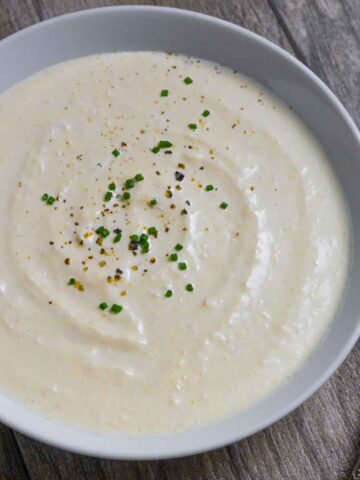
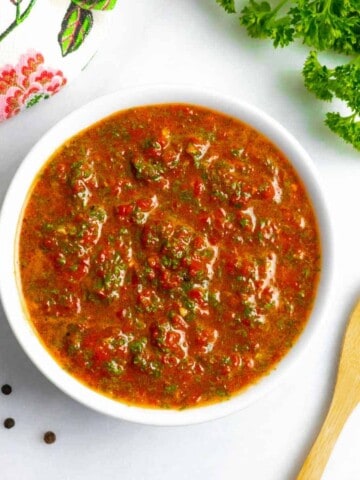
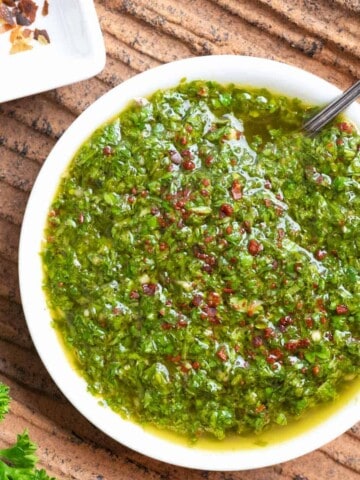

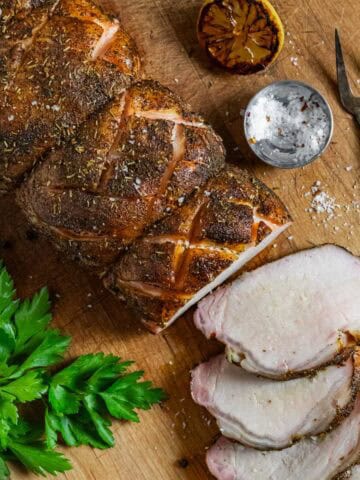
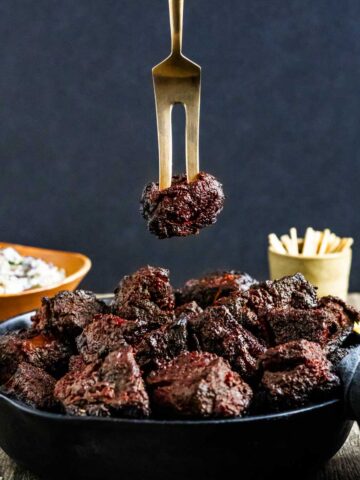

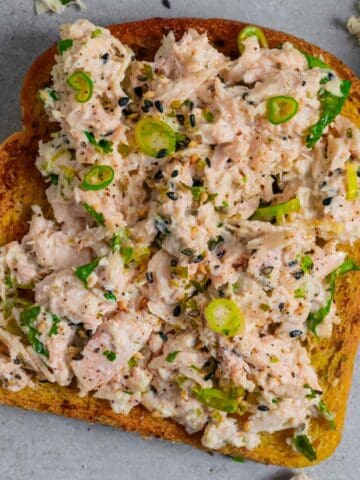
Comments
No Comments